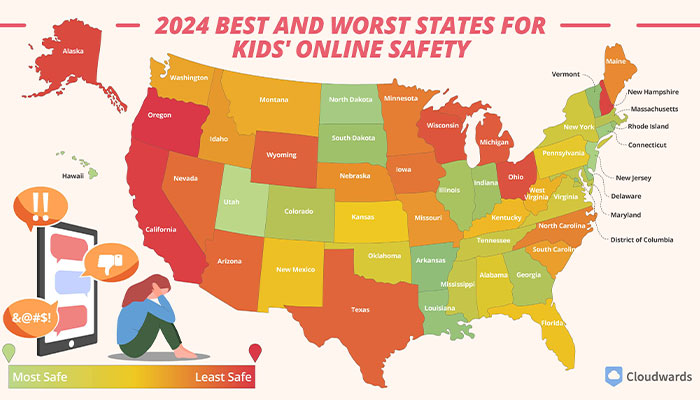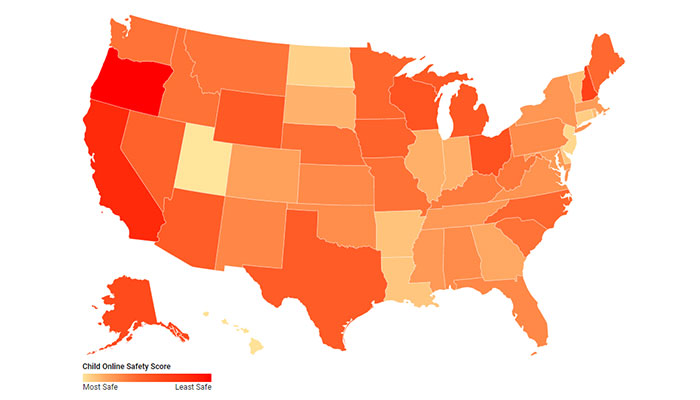California Named Worst State For Kids’ Online Safety Amid Cyberbullying Spike Despite New Laws
California—home to Silicon Valley and a global center for high technology and innovation—has paradoxically been ranked the worst state for children’s online safety in 2024.
The study, published by the online security hub Cloudwards and supported by data from the FBI, shows that the state boasts the highest number of cybercrimes aimed at kids in the United States, including harassment, stalking, and threats of violence.
Bored Panda spoke with the paper’s authors to discuss their findings and uncover what makes the West Coast state so dangerous, in their eyes.
“California has a high number of incidents—250 crimes against children, 1,306 harassment/stalking cases, and 296 threats of violence,” explained Luarda Gjata, Digital Manager at Cloudwards.
“Almost 43% of all kids report being cyberbullied, and 16.7% have admitted to cyberbullying others.”
A study revealed that California has become the state with the highest number of cybercrimes targeting kids in 2024

Image credits: Cloudwards
California shares the top five spot for the worst states for children’s online safety with Oregon, which has the highest number of cyberbullying cases; New Hampshire, known for its high number of harassment cases and low scores for legislation; and Alaska and Ohio, both of which have weak mental health support networks.
California’s authorities seem to be keenly aware of the issue. The report comes in the wake of stricter measures implemented by the state’s Governor, Gavin Newsom, who signed new legislation on September 23 banning cell phone usage at schools.
The Phone-Free Schools Act is the latest statewide attempt to address rising concerns over social media, cyberbullying, and their impact on children’s mental health.

Image credits: Newsweek
According to the study, however, the state is still catching up in terms of legislation, ranking among the top 10 for advancements in that area alongside Utah, Vermont, Georgia, Colorado, Texas, and Florida.
Cloudwards stated that, regardless of these efforts, the number of incidents continued to increase, urging the state to implement further measures.
“While the state has solid laws on cyberbullying, including school sanctions and policies that cover off-campus behavior, it’s missing some key areas, like sexting laws,” Gjata explained.
“Expanding legislation to address that and pushing more digital literacy programs could help bring those numbers down.”
Cloudwards believes that legislation alone has proven to be incapable of controlling the issue, emphasizing the importance of community education and support

Image credits: Birthinjurylawyer
The study emphasizes the fact that social media adoption—and the speed with which it has permeated every facet of children’s lives—has made it impossible for legislation alone to control it.
“The rise in internet and social media use means more opportunities for threats and cyberbullying to happen,” Gjata added.
According to Cloudwards, education and community support are the most relevant predictors of reducing cyberbullying cases across different states.
“Digital literacy is about more than just knowing how to use technology; it’s about understanding the associated risks,” she said. “We need to empower kids with knowledge on identifying and responding to online dangers.”

Image credits: Pexels/Vlada Karpovich
While Gjata and her team recognize the impact of initiatives like those implemented by California’s Governor, they argue that measures should be more comprehensive and involve parents and educators.
“It’s essential that parents, educators, and community leaders work together to create a culture of safety and awareness,” she explained, adding that simply banning phones would not be enough. “Schools should not only teach kids about the risks but also provide resources and support for those affected by online threats.”
According to the study, states that have become technological hubs represent the highest number of cybercrimes against children

Image credits: Pexels/Tatiana Syrikova
Conversely, the most secure states for kids’ online safety are Utah and New Jersey, both of which have the highest scores for safety legislation; Hawaii and North Dakota, which are noted for their low number of incidents of cybercrime and harassment; and Connecticut, recognized for its strong mental health support network.
“Utah made history in 2023 by becoming the first state to pass a social media act ruling that age verification on social media become a requirement, in addition to the restriction of certain features like direct messaging,” explained Kit Copson, one of the study’s authors.
Copson also noted that their research showed a correlation between a city’s technological advancements and the risk to children’s online safety.
“Another observation that piqued our interest is that states containing some of the top tech cities in the U.S., like North Carolina (Raleigh), Texas (Plano, Austin, and Frisco), and California (San Francisco), are among the riskiest areas for child online safety,” she added.
How to protect children from being the target of cyber crimes: According to the study, the key lies in communication and community support

Image credits: Pexels/Greta Hoffman
“Our goal is to highlight these areas based on solid data and raise awareness of the associated risks, hoping that this information will lead to better protections for kids,” Gjata stated, sharing her team’s recommendations with Bored Panda to help families protect their children.
“Never post details like your address, school, phone number, or date of birth anywhere online,” she stated. “The same goes for photos that may reveal details about you, like a photo of a certificate with your full name or your school’s name.”
The study also mentioned how many students allow their profiles to be public in search of online recognition, putting themselves at risk. “Setting your social media profiles to “private” can help you stay safe,” Copson wrote.
Other recommendations include not allowing children to meet with people they’ve only known online, using strong passwords, and not opening links sent by dubious senders.
For Cloudwards, however, the most crucial measure will continue to be regular communication among parents, their communities, and children.
“Let your child know they can always talk to you if they have any questions or feel uncomfortable about something online,” Copson added.
The post California Named Worst State For Kids’ Online Safety Amid Cyberbullying Spike Despite New Laws first appeared on Bored Panda.
No comments